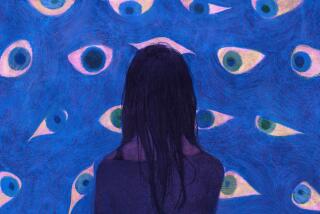Eye-Ay-Ay!
- Share via
Sure, tinted lenses that change eye color have been available for years.
Now, new computer-generated scanning techniques and hand-painted contact lens designs are enabling a radical restoration of what poets once quaintly referred to as “the windows of the soul.”
Imagine costuming your everyday eyeballs with fluorescent smiley faces, psychedelic spirals or colored cat’s eyes. The technology now exists for virtually any graphic--even corporate logos--to be made into a prescription or nonprescription soft contact lens.
And yes, you can see out of these, although some of the more elaborate designs block vision to varying degrees. Depending on the type you’re wearing, driving a car or operating heavy machinery is out of the question.
But these are minor inconveniences to style mavens wishing to coordinate their fashion statements with the ultimate in optical accessories.
Just ask Mitchell Cassel, a New York City optician and innovator in lens coloring, computer-generated scanning techniques and hand-painted lens design. “Club kids are popularizing fluorescent shades and colorful designs like Day-Glo flowers because they look great at night.
“People who love to party, especially at Halloween, are wearing cat’s eye lenses, and I’ve even made hard lenses in a silver mirrored style.” (Soft mirrored lenses will become available “hopefully within the next two years,” Cassel says.) While his company, Custom Color Contacts, sells basic solid color designs for $125 a pair, one of the other top-selling lines he carries is called Crazy Lenses.
Fluorescent models from this line start at $275 and climb in price according to design. Tinted cat’s eye models cost about $350. To obtain a pair, one needs to visit an optometrist or ophthalmologist and have the eyes examined and measured. This information, along with lens style specifics, is sent to Cassel’s office, which then either creates the lenses in-house or has them produced by the manufacturer.
The finished lenses are sent to the eye doctor for dispensing. The colors are safely embedded in co-polymer plastic, and Cassel says a pair should last for several years, if properly cared for.
Cassel did not invent the technology used to create the custom contacts; he credits an international network of eye doctors, laboratories and manufacturers for developing the optical science and art that allow people to “paint” their peepers with virtually any image desired. Cassel became a key player in the esoteric eyeball business by chance about 15 years ago when a student requested a pair of all-black contacts.
“I began designing lenses for people to wear with Halloween costumes,” he says. “Ruby-colored vampire eyes, lizard eyes--I had fun trying them on to see what they looked like, and I’ve even worn the cat’s eyes and the skull and crossbones styles on Halloween.”
Word of his wizardry got around, and Cassel soon found himself creating custom-designed, hand-painted contacts for the medical community as well as for close-up special effects for film, television and rock videos. “The more glamorous projects I’ve worked on for the entertainment industry have helped increase my understanding of how to create better products for the medical community, and vice versa,” he says.
Some of his more striking show business credits include Jack Nicholson’s feral eyeballs in “Wolf” and Robert De Niro’s monster contacts for “Frankenstein.”
Cassel also created orbs for Brad Pitt and Tom Cruise in “Interview With the Vampire.” Replicas of his “Wolf” and “Interview” lenses, which cost $375 a pair, are “steady sellers. Life imitates art.” Movie-goers have also seen Cassell’s handiwork in the form of Tom Cruise’s bloody eye in “Days of Thunder” and in Glenn Close’s eyeball-rolling convulsion scene in “Fatal Attraction.”
Over the years, Cassel has also supplied Arnold Schwarzenegger, Tom Hanks, Michael Crawford and Billy Crystal with tailor-made peepers for their films, and he recently designed reptilian lenses for David Bowie to wear in his “Little Wonder” rock video.
“A lot of my clients are executives and businesspeople who simply want to make their eyes look younger and brighter. As you age, fatty deposits lighten the iris color,” he explains. “Tinted lenses make eyes look more colorful and can help contribute to a more youthful appearance.”
Other types who form Cassel’s client base include “fashion models who would probably prefer to remain nameless,” he says with a chuckle.
But without a doubt, his most satisfying projects are those for the medical community for prosthetic use. “It’s extremely rewarding to make lenses for eyes that have been disfigured by disease or accidents.
“Up until a few years ago, people with damaged eyes had to wear patches. They often led severely restricted lives because they felt terribly self-conscious about their looks. With the new lenses, damaged eyes can now be made to appear beautiful.”
Of course, “Wearing customized lenses can make for great fashion,” Cassel says, “but most important, they can help restore people’s self-esteem and gets them back into social life.”
* Custom Color Contacts can be reached at (800) 598-2020.






